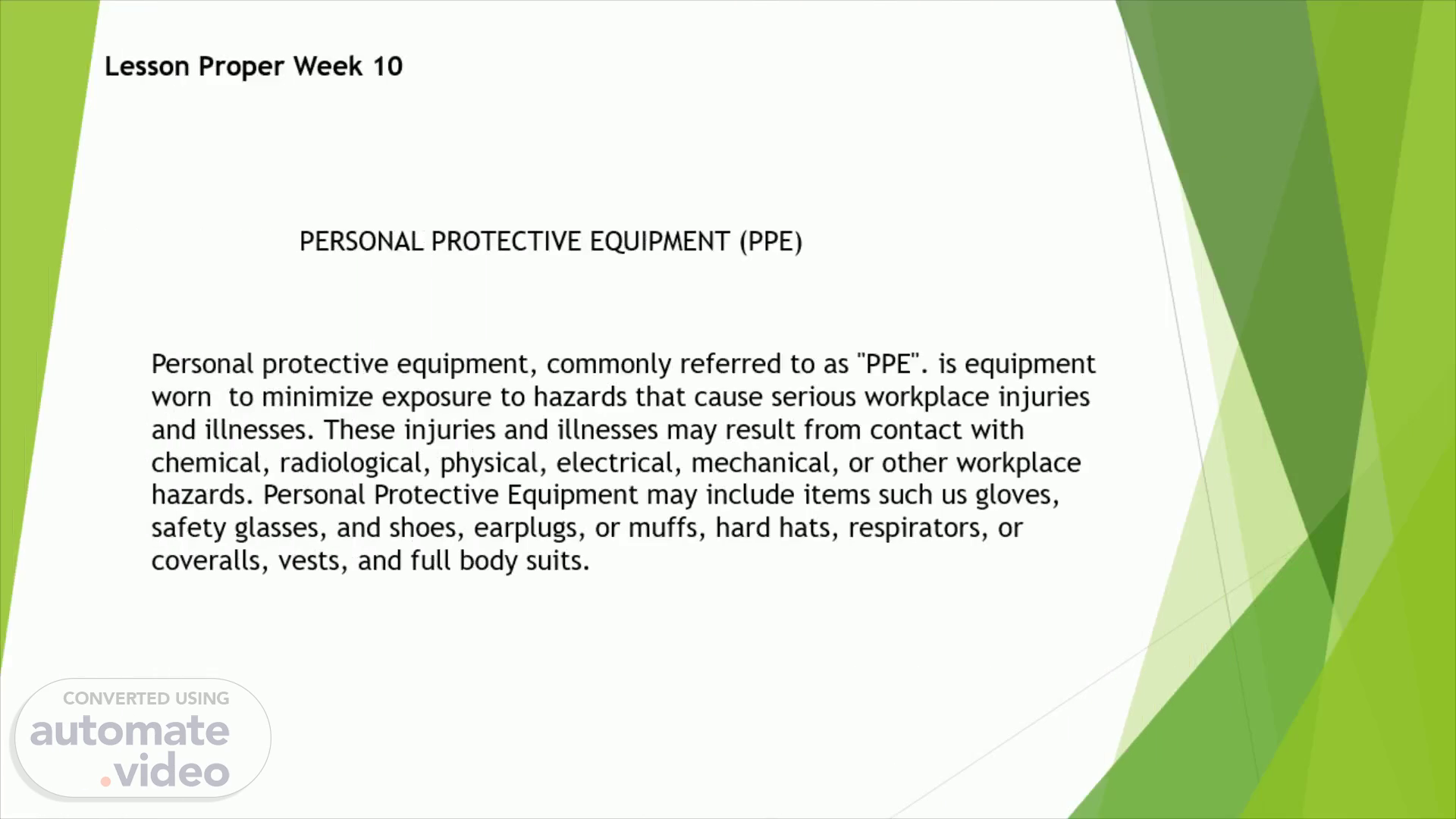
Page 1 (0s)
Lesson Proper Week 10. Personal protective equipment, commonly referred to as "PPE". is equipment worn to minimize exposure to hazards that cause serious workplace injuries and illnesses. These injuries and illnesses may result from contact with chemical, radiological, physical, electrical, mechanical, or other workplace hazards. Personal Protective Equipment may include items such us gloves, safety glasses, and shoes, earplugs, or muffs, hard hats, respirators, or coveralls, vests, and full body suits..
Page 2 (25s)
It is also important to remember that wearing the right PPE is important. PPE does not reduce the workplace hazards nor does it guarantee permanent or total protection for the wearer. Simply having Personal Protective Equipment (PPE) available is not enough. In order to ensure the required level protections: PPE should be selected considering the type of hazard and the degree of protection required. PPE should be useable in the presence of other workplace hazards. Users should be trained in proper use and fit of the PPE. PPE should be properly stored and maintained. If PPE is found to be detective, it should be descarded and replaced..
Page 3 (55s)
PPE is commonly used when working with chemical includes:.
Page 4 (1m 4s)
Industrial or Construction workplaces Safety footwear, eye protection and head protection are minimum requirements for most jobs. Commonly used type PPE in industrial and construction workplaces include: •Head protection (hard hats) for protection against falling objects; •Safety glasses for protection against intense light , UV rays , infra-red rays ( radiation from hot objects) and flying objects, such as wood chips, dust particles and metal pieces; • Earplugs or earmuffs for protection against noise; • Safety footwear for protection against crushing of toes; • Safety gloves for protection against contact with toxic chemicals and electric wires; and • fall protection equipment for protection from falls from heights..
Page 5 (1m 32s)
What can be done to ensure proper use of personal protective equipment?All personal protective equipment should be safety designed and constructed, and should be maintained in a clean and reliable fashion. • When it necessary • What kind is necessary • How to properly put it on, adjust, wear and take it off. • The limitations of the equipment. • Proper care, maintenance, useful life, and disposal of the equipment. Why is PPE important?Making the workplace safe includes providing instructions, procedures, training of employees; and monitoring of the program to ensure its going effectiveness..
Page 6 (1m 58s)
What do I have to do? • Only PPE as a last resort • If PPE still needed after implementing other controls ( and there will be circumstances when it is, eg head protection on most constructions sites). You muts provide this for your employees free of charge • You must choose the equipment carefully (see selection details below) and ensure employees are trained to use it properly, and know how to detect and report any faults. Selection and use You should ask yourself following questions. • Who is exposed and to what? • How long are they exposed for? • How much are they exposed to?.
Page 7 (2m 25s)
When selecting and using PPE. • Choose products which are CE marked in accordance with the personal protective Equipment. (Enforcement) Regulations 2018- Suppliers can advise you. • Choose equipment that suits the user - consider the size, fit and weight of the PPE. If the users help choose it, they will more likely to use it..